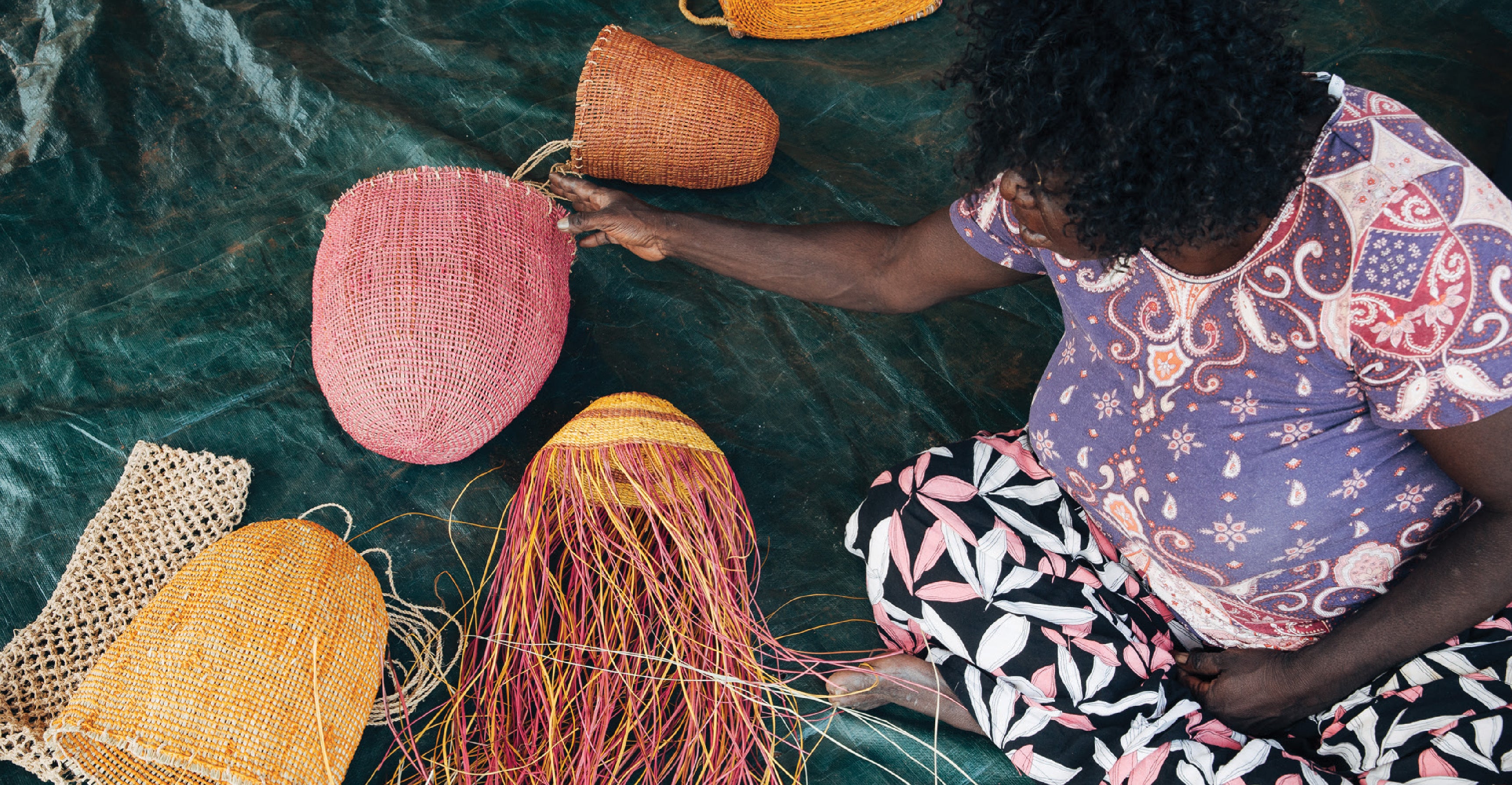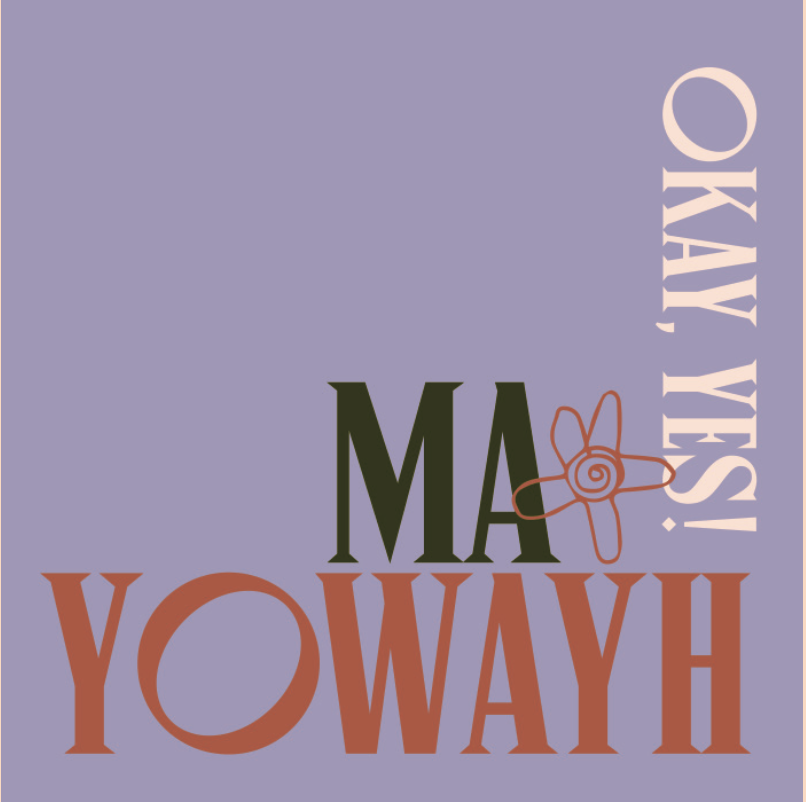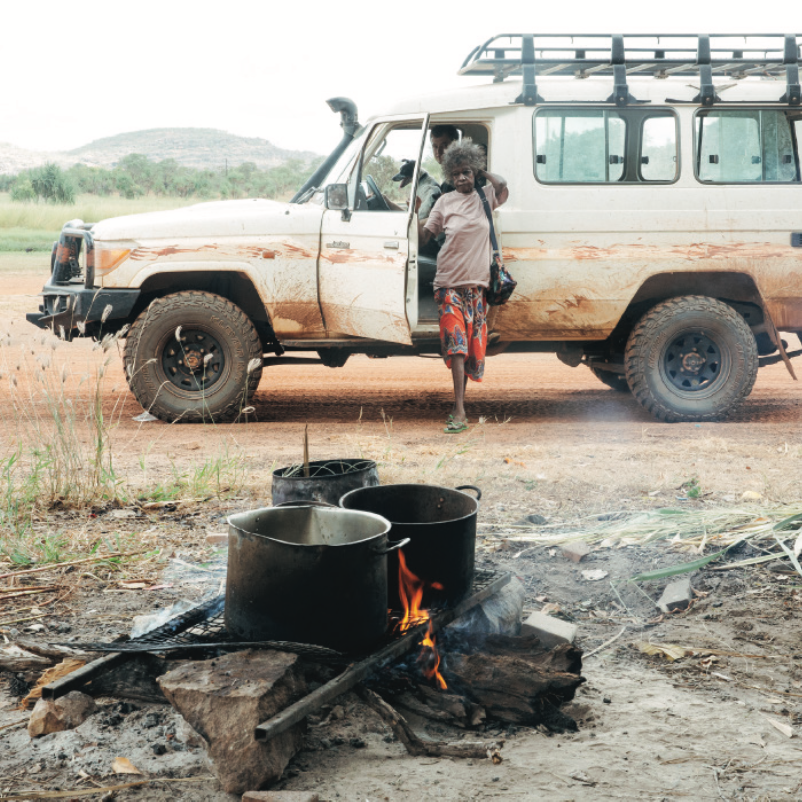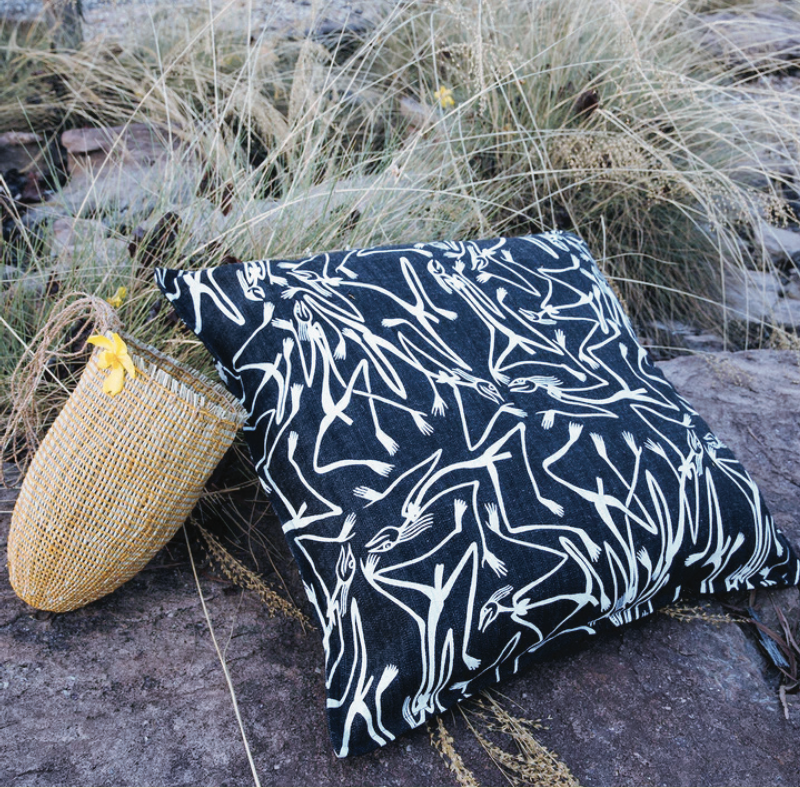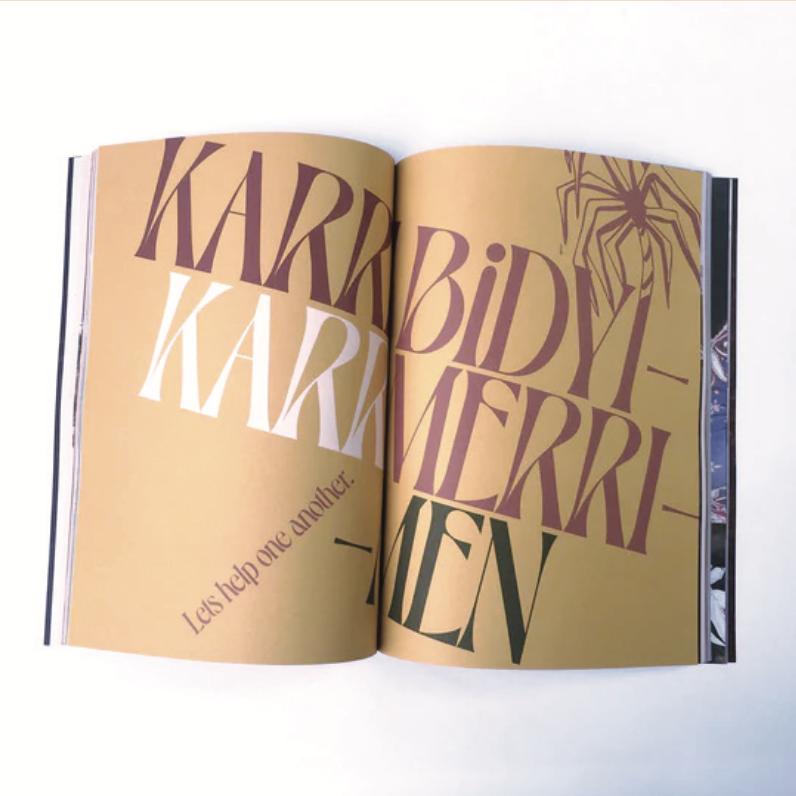Four young leaders take the opportunity to talk about why the creation of a publication for their community is important to them and why they believe their project is worthy of support.
2020 - Inaugural Warlpiri publication "This is Warlukurlangu" by Samara Fernandez
2021 - Publication with West Arnhem "This is Stone Country" by Kabbindi White
2022 - Publication with the Torres Strait Islands "This is Our Islands" by Alex Blanco
2023 - Publication with Tiwi Islands "This is Salt Water Country" by Cassie Puruntatameri.

Name: Cassie Puruntatameri
Title: Editor of "This is Salt Water Country"
Age: 24
Gender: Female
What Indigenous group do you identify with? Tiwi
What region/ communities in Australia are your mob from? Tiwi Islands - Pirlangimpi
What attracted you to the position of editor for a publication and why is doing this publication important to you?
I was attracted to being editor for this publication after seeing the “This is Warlukurlangu” publication in collaboration with North and the community of Yuendumu and Nyrippi. I found the publication very powerful and it was empowering to see how Warlpiri woman Samara Fernandez was able to capture and articulate the story of her beautiful strong community, culture and country.
As a proud Tiwi woman who grew up on country and am strongly connected with my community and culture, I believe it is very important to continue to share our story and culture in a way that is beautiful, authentic, influential, positive and educational. I believe storytelling for all Aboriginal and Torres Strait Islander cultures is very important, and it is more meaningful when our people have that opportunity to have a voice, and our stories are narrated by our own people. Our stories are often told in the media by others and shown in a way that is negative and causes dispute and divide in this nation.
What do you want to showcase about your community?
I want to showcase our loving, welcoming communities and people, our traditional culture, arts, language, ceremonies, healing and land management. I also would like to showcase footy, hunting and gathering off the land and sea, and our history back from the creation story of the Tiwi Islands.
There is so much beauty to show from my home, the Tiwi Islands, many things that keep our culture strong and alive, which is something all Tiwi people are grateful for our ancestors passing their culture down generations. I feel it is very important to showcase our communities and rich culture, one of the oldest continuing cultures in the world over 60,000+ years old and still going strong.
Do you think the publication is a worth-while program? How do you imagine this project would benefits you, artist, and your community?
100%. I imagine this project would benefit us Tiwi people, it will encourage young up and coming in the community to start doing paintings and storytelling through art, and this project will allow us to tell our story in a positive way and allow readers to connect and learn about our culture & in turn will encourage them to visit and connect with the communities, buy our beautiful jilamara (artwork) and may want to personally meet the artists which I imagine would be a special experience.
Could a program like this have an impact on the wider Australian population and the art sector?
Absolutely, I believe it would have a positive impact on the wider Australian population and the art sector! I know a lot of people that love to learn our stories and would love to know more about our culture.
I’m always proudly representing and wearing Tiwi prints on my clothing and sharing Tiwi jilamara (artwork) on social media, and get a lot of people that DM or tell me in person that they love the artwork and are interested in buying those Tiwi prints and paintings & learning more about our culture.
I learnt at a very young age from watching and sitting with my mother, Lydwina (Nina) Puruntatameri, Artist at Munupi Arts Centre, while she’s doing her painting. And to the best of my knowledge I love explaining the stories and talking about our Tiwi culture and art to others everywhere I go. I always feel that I’ve made a positive impact by teaching and engaging with others. I feel unity and understanding both ways, and I will continue to engage and create opportunities for those conversations and knowledge-sharing.

Name: Samara Fernandez
Title: Editor of "This is Warlukurlangu"
Age: 23
Gender: Female
What Indigenous group do you identify with? Warlpiri
What region/ communities in Australia are your mob from? Central Australia- Yuendumu, Nyirripi, Willowra and Lajamanu
What attracted you to the position of editor for a publication and why is doing this publication important to you?
I was attracted to this opportunity for a number of reasons that appealed to both my personal desires and also surpassed person desires. Writing the publication offered me professional skill development in areas I would not usually be gifted. For example, I was given mentoring session with Johanna Bell to improve my writing and storytelling skills. As a psychology student at university, I am not often able to experiment and be creative in the area of storytelling, so I was grateful to dedicate allocated time to this skill development. It is a skill that is often undermined yet invaluable. Storytelling is an ancient art and way of life for Indigenous people. This publication was a big reminder of that.
I was also very attracted to the idea of this publication being the first of its kind. It excited me knowing my community was the pilot for the creation of this new work. It was exciting to visualise how I could through the use of one publication get my community to collaborate in ways I had never seen before. The publication enables full community engagement but in a creative and fun way. It facilitated and strengthened relationships with the different organisations within my community such as the school, art centre and PAW media.
The publication is important to me becauseso often we (Aboriginal and Torres Strait Islander people) are portrayed negatively in mainstream media and painted by the brush of stereotypes and experience extensive prejudice. This publication allows you to hear our authentic voices. Voices from the community. In ways you may not often see, this publication Is a strength-based approach to showcasing art and culture In Innovative and daring ways. It allows for an abundance of different voices across generations to participate and share pride and joy. It is so Important for me that we are seen in truth.
What do you want to showcase about your community?
For the sake of relevance I am going to paste what I wrote in the publication in the letter from the editor section.
2020 has been a year of devastation. We have witnessed our country burn; we are facing a global pandemic and we are in the midst of one of the largest Black Lives Matter movements the world has ever seen. The latter two have affected my home community of Yuendumu firsthand. So why, during such an emotional time did I want to get involved in this magazine?
The answer is simple. I wanted you to see us - not the cliché version mainstream media shows you. The real us. Although this year has been difficult emotionally for me, the opportunity to showcase the beauty within my community was too big an opportunity to miss.
So often we (Aboriginal and Torres Strait Islander people) are portrayed negatively. We are painted by the brush of stereotypes and experience extensive prejudice. I know my community as a place of cultural abundance and saw, in this magazine, an opportunity to show you Yuendumu and what us Warlpiri people are truly like. I want you to hear our authentic voices. I want you to hear how we cope during hard times; to see our resilience and determination. I want you to know our art, and our culture. I want you to feel our pride and love.
I am extremely grateful to have been a part of this project. It has been so special to make something that will make my family and community proud. A publication I am proud of and extremely excited to share with you all. I hope you feel the love and dedication put into this publication with every turn of the page.
To my family, thank you for trusting me with your voices. To my community thank you for the strength you give me. To my colleges and mentors, thank you for your time, effort, and patience. To North, thank you for believing in me, and for giving me this opportunity. I am so appreciative of everyone who has contributed to this magazine.
Though this is the first issue of (Mag name), we hope it is not the last. I hope other Indigenous people get the opportunity to express their love and pride for their communities the same way I lucky enough to. It has been an absolute pleasure to showcase Warlpiri culture with you all.
Please enjoy.
With love,
Samara
Do you think the publication is a worth-while program? How do you imagine this project would benefits your community?
Absolutely! Aboriginal culture streamlined in mainstream media is rarely driven by Aboriginal people and the effects of this can be harmful. Through this medium community members can reclaim the power of their own story and history. The positive outcomes cannot be underestimated.
Storytelling is a powerful tool for sharing culture and talking about what is important. Through the publication you don’t just read the stories you get to see them visually, and you get to feel them. To give agency to communities to showcase their culture, arts and history facilitates a space for healing and endorses cultural pride. I cannot explain the feelings I felt while writing this publication and working with my family. Our Indigenous art is appreciated and admired but often the personal stories are missing, in this way we increase and diversify the representation of our artists and people in remote communities
There is a vast level of benefits. One particular benefit is the engagement and employment of community members- artists, storytellers, musicians, photographers, and students. I was so proud to watch my family step out of their comfort zones; I saw my younger cousins attempt journalism and give interviews for the magazine. I saw them open up about their personal experiences with grief and even saw them model clothing. All new experiences that they may not have gotten the opportunity to experience if not for the publication. They not only enjoyed themselves, they were paid for their time and also gained new experiences and skills. For me this was huge because it combated the “shame” barrier that we often see in community.
Long term one of my favourite benefits is the representation of Warlpiri. Society often shapes our views and our beliefs and therefore an Inability to see yourself in certain spaces (no matter how desired) depicts your desires unattainable. It often crushes dreams before they even have the chance to sprout. How could you believe you were capable of doing something If society never showed you It was possible? In this publication family can see themselves, or someone they know, making goals and dream in the art sector appear more attainable than ever. It Is my goal that that there Is not only a collective pride formed from this publication but that further It creates hope for future generations- It Is vital that young populations see themselves represented in mainstream media, because what you see you believe.
How was your experience working with North?
I had a wonderful time working with North. This was due to Norths approach, they acted merely as a vessel/ platform to showcase Warlpiri culture. They focused on the logistics and allowed me to drive the vision and gave me full creative control to focus on the messages at the heart of community. It was a huge risk and pure experiment, but we were able to innovate a new way of seeing art. I was able to engage in a whole new experience and gifted that to my family also.
We were able to create a space where my community could come together, connect, and celebrate the beauty of being Warlpiri. This was all done in a very respectable manner- North adhered to all cultural protocols in collaborating with community. As an example, every photograph used in the publication was approved by community members, this was particularly important for the images of deceased loved ones. Prior to any movements in community appropriate consultation was taken, for example taking photos on country were only done in locations approved prior.
Through my work with North I was able to engage different organisation in my community to work collaboratively this allowed for the development of strong partnerships. We were able to work across diverse age groups- with young people in school and allowed them to be a part of the creative process. At every turn North staff were constantly seeking validation of me to ensure we were creating the safest environment possible for everyone involved in the project to ensure their wellbeing was a priority and to ensure that they were enjoying the experience.
Could a program like this have an impact on the wider Australian population and the art sector?
Without a doubt. If people are willing to sit and take the time to read the publication, they will learn more than they could have ever imaged. The use of storytelling has been found to increase audience comprehension of another culture- this is invaluable. Personal narratives can work to discredit negative stereotypes that have been absorbed especially by audiences who do not often interact with people from different cultures. The exposure of projects such as this publication are so educational.It showcases the culture and beauty in different communities, showing people the sheer diversity of indigenous Australia and how much our art and culture varies. I think this is a fact often forgotten by non-Indigenous Australia.
I think Indigenous art is critical not only for the obvious reasons such an income for artists and the survival of culture, but because it acts as a medium for those people who support Indigenous art to dive deeper and begin to support Indigenous culture and issues. Projects such as this publication are the perfect place to start because it showcases culture while highlighting community concerns and pride.
Indigenous art carries stories. Every print, every picture, every stoke of paint, every song and every weave holds knowledge, connection, and history. They are passed down through generations, from one family member to the other and to overlook that would be to rob yourself of an opportunity to learn and grow. An opportunity you should never pass up, and could always be of importance to more than just the art sector.
I believe bringing these mediums to a wider audience in a different context allows for greater appreciation of Indigenous art. It innovates the space of art and storytelling and infuses the two to bring about boldness and accessibility. Appreciation is value. It allows you to see art through a different lese, with a new set of eyes. Experience is value. As with everything we are constantly evolving, so should these two spheres. It brings so much joy to our artists to see their designs displayed in a whole new way, and to our communities when we can finally say what we want. And from what I have been told, it has brought also so much joy to allies and wider Australia who are engaging in such projects.

Name: Alex Blanco
Title: Editor of "This is Torres Strait"
Age: 30
Gender: Female
What Indigenous group do you identify with? Magaram Tribe
What region/ communities in Australia are your mob from? Mer Island (Murray Island), Eastern Torres Strait
What attracted you to the position of editor for a publication and why is doing this publication important to you?
I was astounded by the Walukurlangu publication that involves a powerful young woman I consider to be my close friend Samara Fernandez. Being a young Torres Strait Islander man who have never been to the Central Dessert, I had the opportunity to visit her country as part of the Indigenous Marathon Project facilitated by Indigenous Marathon Foundation in November 2020. I purchased the publication from Samara at first hand as I wanted to see and learn more about our First Nations people that has been occupying the lands over many years. I was drawn to learn about her journey and the importance to connect back to country given her challengers and accomplishments showcasing stories through pictures, art, clothing and landscape.
I was drawn to idea and the methodology of this publication. It is important to tell stories where I am from, the cultural diversity and being able to tell a story of what is like being a young man, witnessed Domestic Violence, substance abuse and not to be ashamed to speak about it. The impacts and gravity to uphold being Aboriginal and or Torres Strait Islander Man to be the best they can be. For this reason, which questions the balance of cultural masculinity.
What do you want to showcase about your community?
I want to have the opportunity to show case what is like being a young man growing up in a community sharing stories of other young men show casing their gift through
- Their current way of lifestyle
- Employment
- Art/Music
- Cultural Engagement
Do you think the publication is a worth-while program? How do you imagine this project would benefits your community?
This is a strong platform and wonderful opportunity to be inclusive and transparent with the input and support of grass roots people. It makes sense to run a project with contribution and control from our people, displaying the voice of our stories through this medium.
It will allow and expand on telling stories as it has been taught through generations.

Name: Lorraine Kabbindi White
Title: Editor of "This is Stone Country"
Age: 29
Gender: Female
What region/ communities in Australia are your mob from? West Arnhem Kunwinjku Mok clan
You have already started the process of imagining what a publication would look like for your community. Can you share your vision with us?
Kakadu National Park / Mirarr Country (The gate to Arnhem Land)
- Lend by strong Mirarr women (Aunty Yvonne Margarula)
- Gundjeihmi Aboriginal Corporation
- Ranger and Jabiluka uranium mine
- Post-mining future of Jabiru and the Kakadu region
- Marrawuddi Arts
- Artist and weavers
Kunwarddewarrde – Stone Country
Nawarddeken – Stone Country people
Ankung Djang – Wild Honey Dreaming
The honey bee put the honey into the honey country in Mok clan estate. It placed itself as wild honey, the honey put itself here. Karrdere honey, Nabiwo, Lorlbban Marrkkardba honey types they’re all around here in Ankung kunred.
Kunred dja Kunwok – Country and Language
Warddeken Land Management Ltd. & the Warddeken Indigenous Protected Area (IPA).
The Traditional Owners of the Warddeken Indigenous Protected Area formed Warddeken Land Management Ltd. In 2007. Warddeken is an Aboriginal owned, not-for-profit company that combines traditional ecological knowledge with Western science to manage and protect one of Australia’s most unique environments.
Warddeken Land Management Ltd. Operates out of the remote communities of Kabulwarnamyo, Kamarkarwan and Manmoyi in western Arnhem Land and employs up to 130 Indigenous rangers a year on a casual basis. The Indigenous rangers work on a variety of projects including fire management and carbon abatement, weed and feral animals control, rock art conservation, education and cultural heritage management.
Education on Country (Kunmayali – Knowledge & Education)
The Nawarddeken Academy is a unique bi-cultural school employing a Country as classroom philosophy, with teaching and learning experiences in both English and Kunwinjku, drawing on the natural and cultural landscape of the Warddeken Indigenous Protected Area. The school is in the remote Indigenous community of Kabulwarnamyo and supported by the Karrkad Kanjdji Trust.
Karrdad Kandjdji Trust
Karrkad Kanjdji (pronounced garr-gut gun-jee) is the Kunwinjku name given to us by our founders, the Traditional Owners of the Warddeken and Djelk Indigenous Protected Areas. It refers to the stone country highlands and savanna lowlands of Arnhem Land that we work together to protect.
The Karrkad Kanjdji Trust (KKT) works with Indigenous Ranger groups in one of the most culturally rich and biodiverse regions of Australia, West Arnhem and Central Arnhem Land. KKT brings together ranger groups, communities and philanthropists to address some of our nation’s most pressing issues, including environmental conservation, education and employment.
Kunwarddebim dja Bim – Rock Art & Art
 Our journey
Our journey

